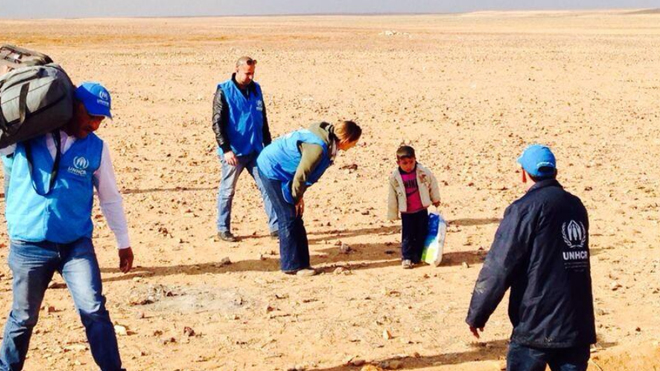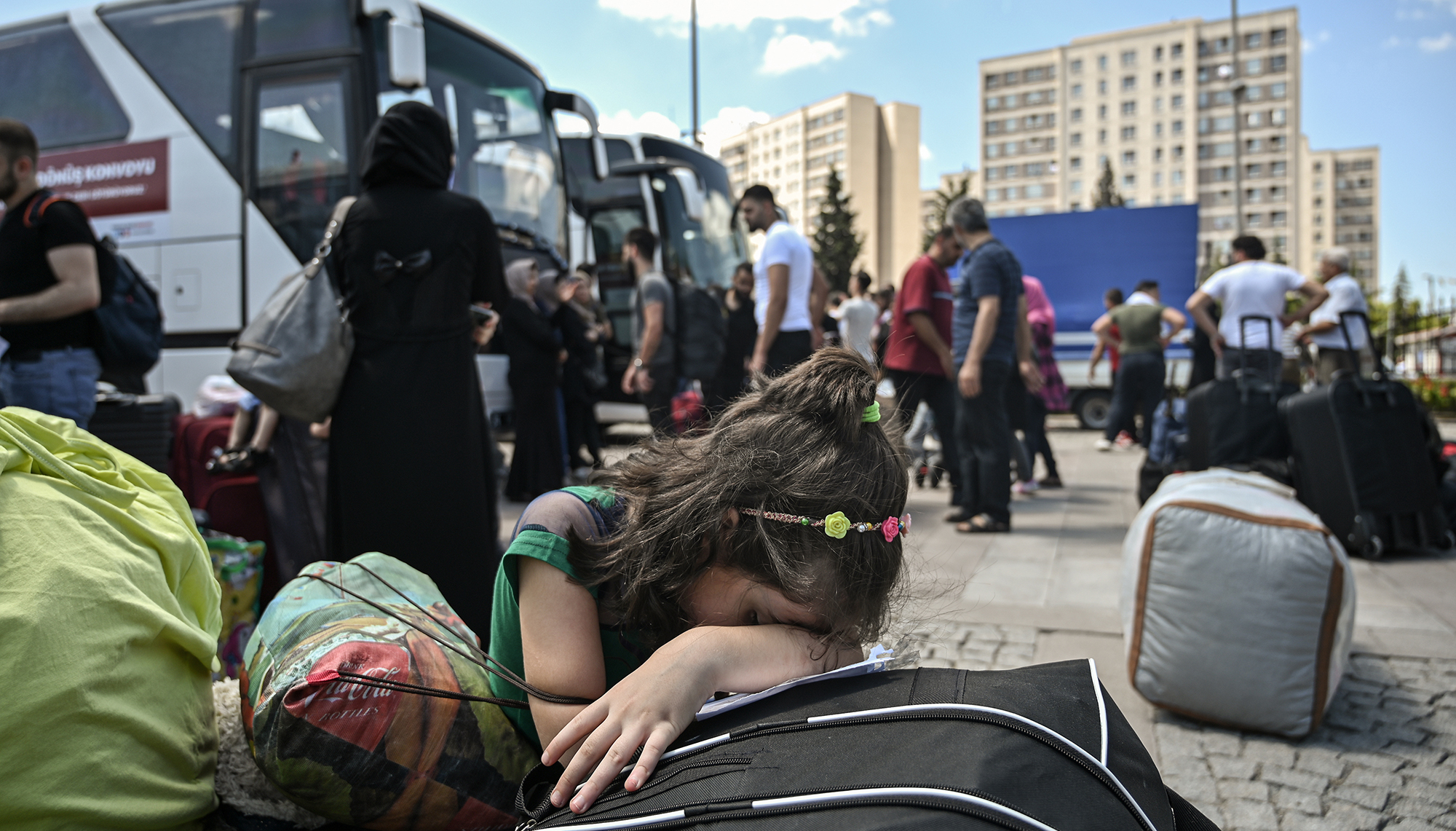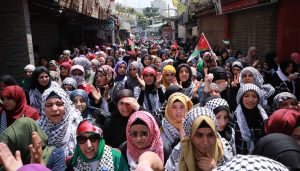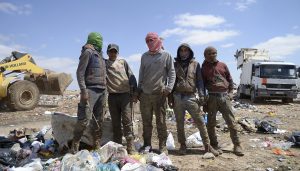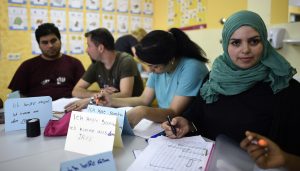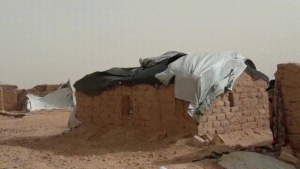By Samar Ahmad
With the Syrian crisis now entering its third year, more than 2.5 million Syrians are currently displaced, both internally and externally. The United Nations High Commission for Refugees (UNHCR) indicates that the number of registered Syrian refugees amounts to: 881,755 in Lebanon; 612,570 in Turkey; 571,457 in Jordan; 222,564 in Iraq; and 133,881 in Egypt. These are actual people, not mere numbers.
Children tend to experience the heaviest loss during wartime. On February 16th, Andrew Harper, UNHCR representative in Jordan, tweeted a picture of a 4-year-old Syrian child referred to as Marwan (to protect his identity) who was temporarily separated from his family during crossing. The picture went viral. On Harper’s post, the picture was retweeted over 900 times and favored by over 300 (including myself). Hala Gorani, CNN anchor, retweeted Harper’s picture, which was retweeted by over 9,000 people. On my Facebook newsfeed, the image was shared over 20 times (it still did not reach the number of condolences that appeared when Amy Winehouse or Paul Walker passed away). Many thought that Marwan crossed the border alone. However, a UN representative on site informed the Guardian that he was a few steps behind his family. With 300-500 Syrians crossing the borders daily, these things are bound to happen.
So, what was the reason behind how strongly people related to this picture and sympathized with Marwan?
Many across the world felt the need to share and talk about this image (they still are, and here I am writing about it). He is a child that could be mine or yours, and in a normal situation he would probably be playing in a backyard, eating a chocolate bar, or being goofy like children his age. Yet, Marwan was carrying a plastic bag filled with belongings, crossing a harsh desert, in freezing weather. We can all agree that this is wrong and unjust. Maybe talking about this image makes us feel better; makes us feel we are contributing to alleviating Syrian suffering; or convinces us that exposing such images might strike a chord, or lead to action that will end the misery, the suffering, and the heartache of Syrian refugees.
The picture humanized Marwan. Marwan is not alone in his misery. Ironically, he could be considered lucky. He found his family and will not face the battle of displacement alone. As of September 2013, the UNHCR registered 1,320 unaccompanied or separated children in Jordan. The number stood at 2,440 in Lebanon. Wandering around the Za’atari camp, I came across a barbed wire area with a caravan and an empty field. I initially thought it was one of the children’s playgrounds, only to be informed by the guard that it was a place for children who cross the border without family members or relatives.
In an interview conducted in September 2013 with Chele Servadei , deputy representative of UNICEF Jordan, he stated that, “since July 2012, when the Zaatari camp first opened, more than 1,000 Syrian unaccompanied or separated children have been identified and provided with care in Jordan, the majority of whom are hosted in the camp.” He added, “unaccompanied children are registered as soon as they reach the camp and are hosted in the UNICEF/IRC interim care centre, where they receive food, basic support, shelter, and psychosocial support. If family members are found, the child is then reunited with them and in accordance with a best interest determination process.” If families are not located, through UNICEF, children are placed with foster families. “64 per cent of unaccompanied children in Zaatari are reunited with a relative or a family member.” According to UNICEF, 4,000 Syrian children crossed neighboring countries borders unaccompanied by family.
According to the Ministry of Education’s data, 83,232 Syrian children enrolled in formal education; 56 per cent therefore, were not receiving formal education
A UNHCR report published in November 2013, The Future of Syria: Refugee Children in Crisis, stated that as of October 2013, the number of Syrian refugee children living was 291,238 in Jordan and 385,007 in Lebanon. The report also shows how the number of Syrian children suffering from psychological repercussions and crisis are exacerbating. In Za’atari camp, 1,379 children were treated for weapon or war-related injuries between October 2012 and October 2013. The majority of children currently face acute depression and distress. Many parents believe that the escaped war is stamped on their children’s memory. Trouble sleeping, horrifying flashbacks, bed-wetting, and speech problems were amongst the troubles with which children are struggling.
The report also indicated that as of September 2013, a total of 187,675 school-aged Syrian refugee children in Jordan were registered with UNHCR, 44,649 in camps and 143,026 in host communities. According to the Ministry of Education’s data, 83,232 Syrian children enrolled in formal education; 56 per cent therefore, were not receiving formal education.
Despite the schools provided by Save the Children and UNICEF in Za’atari, only 12,000 children attend school. The reasons behind low attendance numbers include: taught curriculums are different from Syrian ones, making it difficult for students to follow; some parents fear for their children’s safety and well-being, as schools are located away from their tents; and some children are forced into labor to support their families.
When you enter the camp, there are many children pushing wheelbarrows filled with goods and equipment into the camp or out. They earn approximately 1 JD per day. According to the UNHCR’s report, most of the 680 small shops in Za’atari employ children. It also adds that an assessment in 11 out of 12 governorates in Jordan found nearly one in every two refugee households surveyed relied partly or entirely on income generated by a child.
Rawad, a 7-year-old boy, opted out of school due to psychological problems. According to his parents, his former school, located in Al-Ghouta was bombed while classes were in session. He is now traumatized and fears anything that resembles a school. When I tried to talk to Rawad, he insisted to show me a video on Youtube showing an explosion taking place in his neighborhood. It was very graphic. When I asked his mother why he was allowed to replay such violent and graphic videos, she looked at me in despair. The parents are also going through difficult times trying to fathom the amount of loss and tragedy that has befallen them and their country.
The situation is even worse for refugees who fled Za’atari and currently reside in informal tented settlements across Jordan. Due to their constant relocation it is hard to estimate their numbers. I met some Syrian families living in an area called Ghor Al Mazra’a in the governorate of Al Karak. They attributed their reasons for leaving Za’atari to the harsh weather conditions and employment opportunities. Children have no access to school, playgrounds, or any safe recreational spaces at all.There are no available activities with which they can occupy their time.
According to a recent report titled “Informal Tented Settlements in Jordan: A Multi-Sector, Baseline Assessment” that was published by REACH initiative, “over 3,000 individuals in the governorates of Al Mafraq, Balqa, and Irbid alone are living in substandard conditions, with no or little access to essential services, and with a majority of children not attending school because their parents cannot pay school fees.” This number is projected to increase to 500,000 by end of December 2014. These families lack formal access to basic necessities such as health, education, food, and water.
Syrian children are indeed the biggest losers in this civil war. They are scarred for life. Many have lost a family member, a friend, or heard the story of someone being tortured. The situation is alarming and will only get worse if a political solution in Syria does not unfold.
